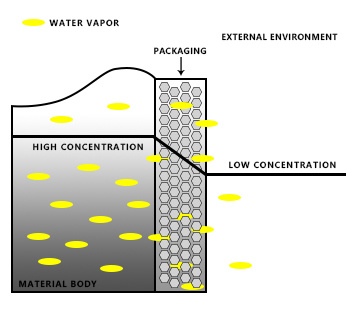Permeation Mechanism
Release time :
2023-02-16
1. The high barrier property of a material to a specific permeate means the low permeability of the material to it. For example, a low oxygen permeability rate means a high oxygen barrier property, and a low moisture permeability rate means a high water barrier property. Barrier properties can be said to prevent permeation, and understanding the permeation process of permeates in packaging materials can help us understand the factors that affect barrier properties. 2. The whole permeation process can be divided into four parts: adsorption, dissolution, diffusion and desorption. Gas, water vapor or organic matter enters the surface of the material from the high-concentration area, and desorbs from the other surface of the low-concentration area through diffusion inside the material. Assuming that the sealed high-moisture cosmetics are in a low-humidity environment, we use this model to simulate the process of moisture loss in the packaging container. As shown in the figure below, water vapor will contact the inner wall of the packaging container, dissolve into the packaging layer, diffuse along the concentration gradient in the material, and finally desorb and diffuse into the atmosphere. This infiltration process is accelerated if the external temperature increases. This can also explain the previously mentioned cosmetics that have been well sealed, but the product will thicken due to the leakage of water vapor and affect consumers' use. 3. The permeation of small molecules through polymers is mainly realized through amorphous regions and crystal defects. Microcracks, pinholes, and defects in the material can all lead to increased permeability. Obvious material defects can be seen under a high-power microscope.
In the previous issue, we introduced the definition of material barrier. In this issue, we will introduce the permeation mechanism. Reminder: It is recommended to read the first and second chapters first, which is helpful for reading this chapter.
First of all, I will divide the penetration mechanism into three points for you to explain.
1. The high barrier property of a material to a specific permeate means the low permeability of the material to it. For example, a low oxygen permeability rate means a high oxygen barrier property, and a low moisture permeability rate means a high water barrier property. Barrier properties can be said to prevent permeation, and understanding the permeation process of permeates in packaging materials can help us understand the factors that affect barrier properties.
2. The whole permeation process can be divided into four parts: adsorption, dissolution, diffusion and desorption. Gas, water vapor or organic matter enters the surface of the material from the high-concentration area, and desorbs from the other surface of the low-concentration area through diffusion inside the material. Assuming that the sealed high-moisture cosmetics are in a low-humidity environment, we use this model to simulate the process of moisture loss in the packaging container. As shown in the figure below, water vapor will contact the inner wall of the packaging container, dissolve into the packaging layer, diffuse along the concentration gradient in the material, and finally desorb and diffuse into the atmosphere. This infiltration process is accelerated if the external temperature increases. This can also explain the previously mentioned cosmetics that have been well sealed, but the product will thicken due to the leakage of water vapor and affect consumers' use.

3. The permeation of small molecules through polymers is mainly realized through amorphous regions and crystal defects. Microcracks, pinholes, and defects in the material can all lead to increased permeability. Obvious material defects can be seen under a high-power microscope.

The permeation mechanism in this chapter is finished, and the next chapter will explain the factors that affect the barrier properties of polymer materials.Welcome everyone to pay attention to us, we are a professional manufacturer integrating production and sales.
E-mail: Jacky@zhbaoli.com
P.O.BOX: 519085
Address: No. 196, Nazhou Second Village, Tangjiawan Town, Xiangzhou District,
Zhuhai City, Guangdong Province, China
Related news


 Jacky@zhbaoli.com
Jacky@zhbaoli.com Feedback
Feedback +853-63198682
+853-63198682